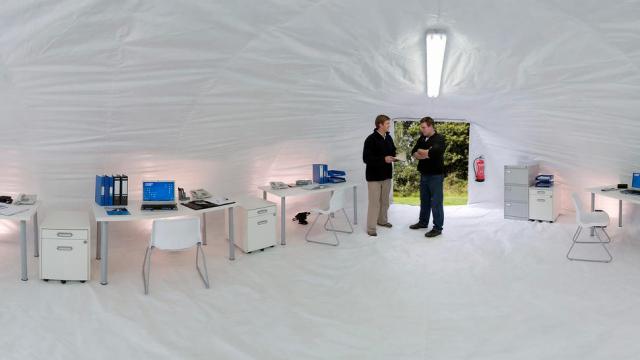Describing architecture as “instant” can mean different things to different people. During the post-War housing shortage, it meant prefab homes that went up in weeks. For disaster survivors, it can mean something as simple as a shelter that’s assembled in hours. For the military, instant architecture is closer to instant — aircraft hangars and medical tents that pop up in mere minutes.
Over the past few decades, as warfare has changed and climate change has hastened the frequency of severe weather, we’ve seen “instant” buildings emerge as a topic in design schools and relief organisations. From shipping containers that unfold at the touch of a button to “buildings-in-a-bag” that need only water and air to be assembled, we’re experiencing a renaissance in rapidly deployable architecture. 10 interesting examples — including a few from the past — follow.
Jean Prouvé’s Maison Aluminium Métropole
Jean Prouvé, who died in 1984, was one of the earliest Modern designers to push prefabrication. This classroom was the winning entry from a 1949 competition run by the French government, which asked architects to imagine a prefab design that would provide a classroom and teacher housing in rural areas. Only 15 of the buildings were ever produced — but the design was definitive in modern architecture. This stop-motion video shows one of the sets being assembled as part of a recent exhibition on Prouvé’s work.
Assembly time: six days.
Building In a Bag
Cement-impregnated cloth gives these shelters — which go up in under an hour — their nickname: “building in a bag”. To set up the hard-shell tents, you spray the concrete cloth with water drape it over an inflated balloon until it dries. It’s fireproof, immune to snow and rain, and lasts as long as a decade.
Assembly time: an hour or less.
QuaDror by Dror Benshetrit
QuaDror is actually a structural component developed by the Israeli product designer Dror Benshetrit. But the idea behind QuaDror, a disaster housing concept, is that the component can serve as a basic hinge for building shelter out of whatever happens to be lying around: wood, metal, plastic, whatever can be found. It’s a smart proposal, because even though it requires a bit of work on site, it’s cheaper (and faster) to transport small components rather than entire shelters.
Assembly time: one day.
Shelter System for the B-2 Stealth Bomber
Why does the B-2 need its own storage system? Because its stealth coatings require exacting temperature controls to maintain. And when the plane is in action, a good hangar isn’t always easy to find. So the US Air Force contracted a company called American Spaceframe Fabricators to design a system that can be transported anywhere and goes up fast. The military now owns a handful of the massive structures, which can be disassembled and reassembled as needed, and have a unique clam-shell retractable entryway to accomodate the plane’s wingspan. Similar shelters are used to provide shelter for smaller aircraft, like these clamshell-style pop-up hangars.
Assembly time: roughly 10 days.
Onagawa Temporary Container Housing by Shigeru Ban
Japanese architect Shigeru Ban devoted most of his office’s resources to helping the displaced find shelter after the 2011 tsunami. This community, in the town of Onagawa, gave earthquake survivors a place to live as their town was being rebuilt. Stacked shipping containers supply 1800 units of temporary housing, and one very beautiful community centre provides meeting space.
Assembly time: several months.
Mobile Housing by Yatsutaka Yoshimura
Japanese architect Yatsutaka Yoshimura recently unveiled a proposal for a mobile housing unit built to the specifications of a shipping container. This way, the finished homes can be transported to the crisis site aboard flatbed trucks, rather than assembled when they arrive.
Assembly time: one day.
Uniteam’s Collapsible Military Shelters
The Rapid Deployment Shelter System, or RDSS, arrives in a standard shipping container and unfolds at the touch of a button. The system was designed to improve on the military’s standard tent system, giving military hospitals and combat centres instant access to air conditioning, Wi-Fi and electricity.
Assembly time: two minutes.
Daisuke Sugawara Hosuing by Azuhito Nakano
Being displaced from your home after a disaster affects people in a whole host of long-term ways, ranging from financial to emotional. The concept behind this community of 60 homes in Rikuzentakata (an area “wiped off the map” after the tsunami in 2011) was to encourage interaction between residents. The architects arranged the homes in an interlocking pattern that connects garden to garden — the hope being that residents will run into each other more often and build relationships.
Assembly time: a few weeks.
Softshelter by Molo Design
In the weeks following the same tsunami, thousands of displaced people were forced into gyms and schools to live indefinitely. The Canadian design studio Molo had that in mind when they designed Softshelter, a pliable, light division system that would allow survivors to create their own semi-private, functional living space within a shelter or relief centre.
Assembly time: roughly 20 minutes.
Liina Transitional Shelter
“According to a 2007 report by Christian Aid,” write the students behind this brilliant flatpack shelter, “the number of refugees worldwide is expected to exceed 1 billion by 2050.” Liina, a modular shelter designed by Aalto University students, is intended to provide a temporary home for up to five years. Using a system of interlocking wood panels and simple fabric straps, Liina only takes six hours to assemble after it’s unpacked from its shipping container. And remarkably, it requires zero power tools.
Assembly time: six hours.
